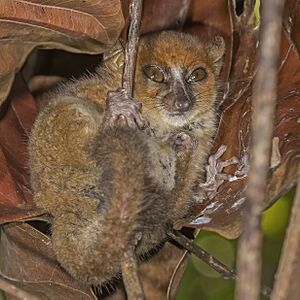Claire's mouse lemur facts for kids
Quick facts for kids Claire's mouse lemur |
|
|---|---|
 |
|
| in Lokobe Strict Reserve, Nosy Be | |
| Conservation status | |
| Scientific classification | |
 |
|
| Distribution of M. mamiratra | |
| Synonyms | |
|
Claire's mouse lemur (Microcebus mamiratra) is a very small lemur. It is also known as the Nosy Be mouse lemur. This species was only recently discovered by scientists. It belongs to a group of tiny lemurs called mouse lemurs.
Claire's mouse lemur lives on an island called Nosy Bé in Madagascar. It also lives on the mainland nearby, especially around the village of Manehoka and in the Lokobe Reserve.
The scientific name for this lemur is Microcebus mamiratra. The word mamiratra comes from the Malagasy language. It means "clear and bright." This name honors the Theodore F. and Claire M. Hubbard Family Foundation. This group helped fund important genetic research in Madagascar.
About Claire's Mouse Lemur
What It Looks Like
Claire's mouse lemur is about average size for a mouse lemur. It weighs around 60 grams. That's about the same as a small apple!
Its fur on its back and upper body is reddish-brown. The color gets a bit darker in the middle of its back. Its tail is also reddish-brown. But its belly is white or creamy in color.
From its head to the tip of its tail, this lemur is about 26 to 28 centimeters long. Its tail alone is quite long, measuring 15 to 17 centimeters.
Is It a Separate Species?
Scientists are always learning new things about animals. Recently, some scientists looked closely at Claire's mouse lemur. They wanted to see if it was truly a different species from other mouse lemurs.
They studied its DNA. DNA is like a special code that tells us about living things. They looked at two types of DNA:
- Mitochondrial DNA: This DNA is passed down only from the mother.
- Nuclear DNA: This DNA comes from both parents.
The study found that the mitochondrial DNA of Claire's mouse lemur was different from the nearby Sambirano mouse lemur. But its nuclear DNA was very similar.
This might be because female mouse lemurs tend to stay close to where they were born. This is called "philopatry." Because females stay in one area, their mitochondrial DNA (from their mothers) stays similar in that small area. But nuclear DNA, which mixes from both parents, can be similar over a much larger area.
Because of these findings, some scientists now suggest that Claire's mouse lemur might not be a completely separate species after all. Science is always changing as new information is found!


